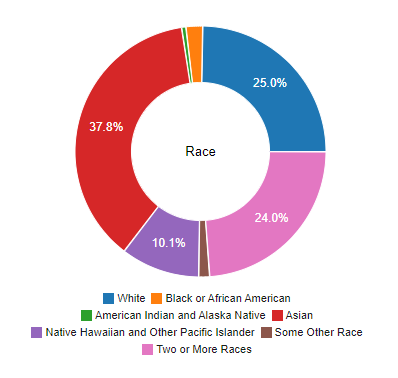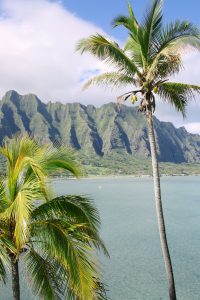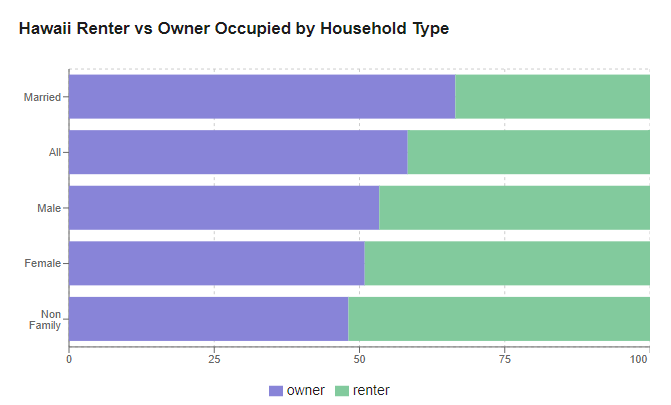Geographically, Hawaii is unique among U.S. states. The only state composed entirely of islands, it sits in the middle of the Pacific Ocean. Just below the Tropic of Cancer, Honolulu is on a latitude with Mexico City and Havana, nudging aside Key West. Fla., for bragging rights to being the United States’ southernmost city. A motorboat ride east of the International Date Line, Hawaii is two hours behind Pacific Time, a distinction it shares only with some barely populated rocks in Alaska’s western Aleutian Islands.
Who Lives in Hawaii?

Hawaii is the only plurality-Asian state in the Union — majority-Asian, depending on how you count people of mixed ancestry. Filipinos and Japanese are the largest ethnic groups, followed by pre-contact Polynesians. There are slightly more women than men living in the state, and roughly half the adult population is married. The median Hawaiian is 36.2 years old and the median resident of Honolulu is 39.7, in line with a national median of 38.1.
More Interesting Demographics about Hawaii
The entire economy is predicated on tourism. More than 14% of all employed Hawaiians are directly engaged in the sector, and most of the rest are in public-sector careers related to education, health care or government service. Within greater Honolulu — essentially the island of Oahu — there are also a lot of retail sales jobs and positions on maritime crews. It should be noted that the unemployment rate in Hawaii is persistently lower than that in the U.S. overall.
Considering that almost one out of three Hawaiians 25 years of age or older is a college graduate, one can surmise that there are lots of people willing to settle into underemployment if it means living the tropical lifestyle. The weather is nothing if not predictable. While Hawaii sees a lot of precipitation, it’s warm rain. City-data.com ranks Honolulu first among major U.S. cities for the smallest temperature differences during a year.
Politically, Hawaii usually has a big, blue “D” next to it, but that’s not an absolute. Certainly, native son Barack Obama did exceedingly well in the Aloha State but, in 2004, George W. Bush came very close to adding it to the Republican column as he won his second term. Religiously, Hawaiians tend to be more secular than mainlanders. While there is a significant Catholic presence and a smaller Protestant one, roughly two-thirds of the population adhere to no religion. Most non-Christians who follow a religion are Shinto Buddhists.
Oahu is just one of eight major islands in the archipelago, arranged politically into five counties. (There is effectively no city- or town-level government.) One of those counties is a former leper colony that was closed off in 1969 and fewer than a hundred people are still alive there. Of the rest, more than two-thirds of the population lives in the City and County of Honolulu, otherwise known as the island of Oahu. So that’s where we’ll zero in.
Beyond the Tiki Bars
 Most of what you think of as Polynesian art and culture is pure baloney. “Tiki culture” was invented by Californians to reflect some idealized version of South Pacific hedonism. Even the Mai Tai — the rum-curaçao-umbrella concoction emblematic Honolulu’s touristy Waikiki Beach — was invented in Oakland.
Most of what you think of as Polynesian art and culture is pure baloney. “Tiki culture” was invented by Californians to reflect some idealized version of South Pacific hedonism. Even the Mai Tai — the rum-curaçao-umbrella concoction emblematic Honolulu’s touristy Waikiki Beach — was invented in Oakland.
There’s nothing magical about Honolulu. It’s just another city, with the same benefits and challenges as other cities. But, like all cities, it also has its own unique cultural flairs and neighborhood personalities.
(The weather is really, really nice, though. There’s no getting past that.)
There are 18 neighborhoods in Honolulu,” according to Norada Real Estate Investments, which focuses on the single-family market. “Some of the best … are Waikiki, Ala Moana-Kakaako and Hawaii Kai. Waialae-Kahala has a median listing price of $1.9M, making it the most expensive neighborhood. Makiki- Lower Punchbowl-Tantalu is the most affordable neighborhood, with a median listing price of $408,000.”
Renters vs Homeowners
The single-family option is gaining ground at the expense of the multifamily market, and the stark economics of the buy-versus-rent decision appears to be driving it. Writing for Norada, Marco Santarelli reports that Honolulu is the single least affordable market in the U.S. for apartment rentals or condo purchases. This dynamic will get worse before it gets better, as a 1%-to-2% annual population increase is expected to lead to a shortfall of 26,000 units in the next decade. When you consider that there’s a baked-in need for rental units from the strong U.S. military presence and the off-campus housing needs of the University of Hawaii, the demand keeps piling up.

“Roughly sixty percent of Hawaii residents are cost-burdened renters, people who spend more than a third of their income on rent,” Santarelli continues. “Compounding the matter is that they’re competing with several large pools of renters who are almost immune to local economics, driving up rental rates.”
Such efforts as The Michaels Organization’s $41 million, 320-unit affordable housing project currently under construction in Ewa Beach will barely make a dent. Altogether, fewer than 1,500 new low-rent units come online in a typical year.
Still, low property taxes and a generally developer-friendly City Hall spur continued growth in the real estate market overall.
It should be noted that one unique feature of the Honolulu market is that multifamily real estate is almost an afterthought. While $608.8 million was invested in apartment construction in 2018, according to CBRE, that pales in comparison to the $1.6 billion funneled into retail and $2.4 billion into hotels.
Trouble in Paradise
So Honolulu is a much more nuanced place than the Elvis movies would have you believe. Contrary to trends on the mainland, crime is rising and air quality is falling.
There are geopolitical issues to consider as well. Honolulu Harbor is, as we’re reminded every December 7, a strategically important location. We now fight wars across the Pacific with tariffs on computer parts and soybeans rather than with aircraft carriers and heavy bombers. Tensions in the region are nonetheless tense. The fallout for multifamily real estate is that some investors — not to mention potential residents — are waiting for tempers to cool before committing their money.
“Overall across Hawaii, home sales grew 12.3% while prices fell slightly by 2.5%,” Gord Collins reports for property management software vendor ManageCasa. “Homebuyers may be waiting for the trade deal to happen before committing to buying in Hawaii. Yet, even with the tariff slowdown period, prices haven’t dropped much.”
Maybe that’s because of the one, immutable truth about Hawaii: Land itself is at a premium. There will never be enough paradise to go around.
Honolulu at a Glance
 Population: 953,000 (2010, Oahu total)
Population: 953,000 (2010, Oahu total)
Unemployment rate (2019): 2.9%, compared with a national average of 3.7%
Average household income (2017): $138,492, compared with a national average of $48,150
Cost-of-living index: 172.3 (2019), compared with a national average of 100
Source: City-Data.com


